| | |         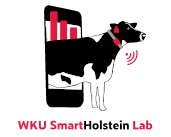  | - Home
- Breed History
- Facts
- Dairy Terms
- Cattle Care
- A "Good Cow"
- Pedigrees
- Photos
  
| | When migrant European tribes settled the Netherlands close to 2,000 years ago, they wanted animals that would make the best use of the land. The black cattle of the Batavians and white cows of Friesians were bred and strictly culled to produce animals that were the most efficient, producing the most milk with limited feed resources. These animals genetically evolved into the efficient, high producing black-and-white dairy cow, known today as the Holstein-Friesian (or more simply, "Holsteins"). When markets began to develop for milk in America, dairy breeders turned to Holland for their cattle. Winthrop Chenery, a Massachusetts breeder, purchased a Holland cow from a Dutch sailing master who had landed cargo at Boston in 1852. The cow had furnished the ship's crew with fresh milk during the voyage. Chenery was so pleased with her milk production that he imported more Holsteins in 1857, 1859 and 1861. Many other breeders soon joined the race to establish Holsteins in America. By the late 1800s, there was enough interest among Holstein breeders to form associations to record pedigrees and maintain herdbooks. These associations merged in 1885, to found the Holstein-Friesian Association of America. In 1994, the name was changed to Holstein Association USA, Inc. Genetic Progress The artificial insemination (A.I.) industry has had a tremendous impact on genetic improvement of the breed. Since perfection of the semen freezing process in the late 1940s, A.I. has allowed Holstein breeders across the country to use a wide range of bulls with high genetic value, allowing them to make more rapid genetic improvement in their cattle. Today, calves resulting from A.I. account for more than 85 percent of Holstein births. Through A.I., a single Holstein bull can sire more than 50,000 daughters. Type and production information on all these females makes it easier to predict performance of future offspring and evaluate the quality of genetics transmitted from sire to offspring. In the late 1960s, the AI industry, the Dairy Herd Information Association (DHIA) and breed organizations, including the Holstein Association, worked together to develop tools which dairy producers could use to breed their cattle for improvement. They used type and production information and research data from universities to develop measures Holstein breeders now use to evaluate bulls and select sires according to their needs. Today, dairy producers have the ability to utilize genomic technology to discover the genetic potential of their animals at an earlier age than ever before. Genomic testing analyzes the DNA of an animal to determine what genes they actually possess, information that can be used to estimate future performance more reliably than simply taking an average of the parents' genetic values. The majority of bulls that enter A.I. are genomic tested, and many breeders are genomic testing their females to make more educated breeding decisions, particularly on heifers. One thing is for certain - technology is constantly evolving, with more tools being added to breeders' arsenal of options to consider in their journey to breed a better cow. Such convincing evidence of genetic superiority has created an active export market for U.S. Holstein genetics. Live Holstein females and males, as well as frozen embryos and semen are being exported to numerous countries worldwide and used extensively to improve foreign food supplies and dairy producer incomes. Recommended Reading: - Progress of the Breed: The History of U.S. Holsteins, by Richard H. Mansfield
| |
 | 
| |  - Holstein cattle are easily recognizable by their distinctive black and white markings, but may also be red and white in color (caused by a recessive genetic trait).
- Mature Holstein cows typically weigh around 1,500 pounds and stand 58 inches tall at the shoulder, making them the largest of the U.S. dairy breeds.
- Holsteins are known for their outstanding milk production, desirable phenotypic characteristics, and adaptability to a wide range of environments.
- There are over 9 million dairy cows in the U.S., with approximately 90% of them being of Holstein descent.
- Holsteins can thrive in the many various management settings of the U.S. dairy industry, and can be found from coast to coast.
-
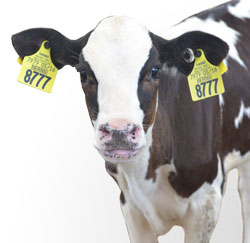 Holstein cows typically calve for the first time when they are 23 to 26 months of age, with healthy calves weighing an average of 80 to 100 pounds at birth. Holsteins have a gestation period of nine months. Holstein cows typically calve for the first time when they are 23 to 26 months of age, with healthy calves weighing an average of 80 to 100 pounds at birth. Holsteins have a gestation period of nine months. - Holstein cows give more milk than any other dairy breed in the U.S. The average Holstein cow produces around 23,000 pounds of milk, or 2,674 gallons, of milk each lactation. With a standard lactation lasting 305 days, that comes out to 75 pounds, or almost 9 gallons of milk per cow per day.
- The world record for milk production was set by a Holstein cow in 2017 when "Selz-Pralle Aftershock 3918", a cow from Wisconsin, produced 78,170 pounds of milk in a year.
- Black and white Holstein cows have claimed Supreme Champion honors, the highest recognition given for elite phenotypic characteristics, at the world's largest dairy cattle exhibition, the World Dairy Expo (held each fall in Madison, Wis.) 35 times in the past 51 years.
Download a printable fact sheet about U.S. Holstein cattle Learn more about why Holsteins are the breed of choice for U.S. dairy producers. Watch this short video to learn more about our members and the
Holstein cow's significance to U.S. agriculture. | |  | 
| | When talking with "cow people" or reading about cattle, it's handy to know the lingo! Following is some very basic terminology which anyone learning about cattle should understand. |
| | Artificial Insemination (A.I.): | A standard practice on most dairy farms today, involving a dairy producer or trained technician inserting frozen semen into a cow's uterus. This is a common procedure as it is quick and easy to perform, allows dairymen to utilize a wide variety of high quality genetics in their herd, and avoids the health and safety risks involved with keeping a mature bull on the farm. Commonly abbreviated as "A.I." | | |
| | Bovine: | Of or relating to cattle (dairy or beef) | |
| | Bull: | A male bovine of any age | |
| | Calf: | A young bovine of either gender, typically describes animals from newborn up to a year old | |
| | Calving: | The act of a cow giving birth; also known as "freshening" | |
| | Classification: | A system of assigning numeric values to various parts of a cow, based on how well they compare to breed ideals. Performed by trained Holstein classifiers, the result is an official final "classification score," which gives the owner unbiased information on how their cattle rank compared to the breed standard, and can give other interested parties an idea of what the cow looks like without seeing her, based on her scores. | |
| | Conformation: | The physical appearance of a bovine, including their bone structure | |
| | Cow: | A female bovine who has given birth at least once | |
| | Crossbred: | An animal whose parents were of different breeds; not purebred | |
| | Dam: | The mother of an animal | |
| | Dry (Cow): | Cows who are not lactating currently; typically pregnant and due to calve within two months | |
| | Ear Tag: | 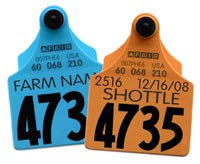 A plastic or metal tag which is placed in an animal's ear A plastic or metal tag which is placed in an animal's ear
(typically at birth or soon after) for identification purposes | |
| | Freestall Barn: | A type of housing system where cows are housed in large group pens, with free choice access to feed, water, and comfortable stalls to lay in. Stalls in freestall barns are typically bedded with sand, straw, or some type of mattress. 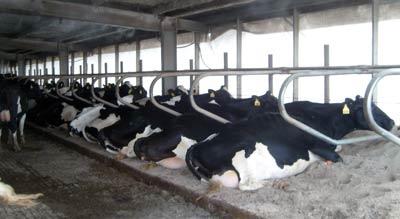
Modern Freestall Barn | |
| | Fresh (Cow): | A cow who has recently given birth (or "calved"); the act of giving birth ("calving") is sometimes described as "freshening" | |
| | Genotype: | An animal's genetic makeup | |
| | Heifer: | A female bovine who has not yet given birth; typically describes animals younger than two years old | |
| | In Heat: | A cow's fertile period when she may become pregnant, indicated by increased activity and other hallmark signs. Most cows cycling normally come into heat every 21 days. This period is also referred to as "estrus." | |
| | Lactation: | The stage of a cow's life where she is producing milk after having calved. Most cows lactate for between 300 to 365 days before going into a dry period. | |
| | Milking Parlor: | Central area of a barn where cows come to be milked | |
| | Pedigree: | 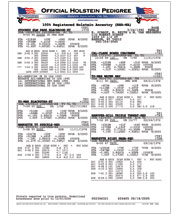 A document showing an animal's lineage, a record of their ancestry; a typical Holstein pedigree shows three generations - the animal itself, its sire and dam, along with their sires and dams. May also list genetic and performance records for each animal, when applicable. A document showing an animal's lineage, a record of their ancestry; a typical Holstein pedigree shows three generations - the animal itself, its sire and dam, along with their sires and dams. May also list genetic and performance records for each animal, when applicable. | |
| | Phenotype: | An animal's physical characteristics and appearance | |
| | Polled: | An animal born naturally without horns (and no ability to grow them). Polled is a dominant trait in Holstein cattle, but the majority of Holstein cattle are not polled. | |
| | Progeny: | The offspring of an animal | |
| | Purebred: | An animal whose ancestors are of the same breed. | |
| | Registered: | An animal whose lineage is formally recorded and tracked through its respective national breed association | |
| | Showing: | Exhibiting an animal at a fair or other show, where a judge evaluates and ranks cattle based on their physical appearance and conformation to breed standards and ideals. At shows, animals are typically split into classes based on their breed and age; shows are typically for purebred and registered animals only. | |
| | Sire: | The father of an animal | |
| | Steer: | A male bovine who has been castrated and is being raised for beef production | |
| | Tie-Stall Barn: | A type of housing system where cows remain in an assigned stall for most of the time, with free choice access to food and water. Cows in tie-stalls (also called "stanchion barns") are milked in their stalls (rather than walking to a milking parlor), and typically turned out to exercise for a portion of the day. 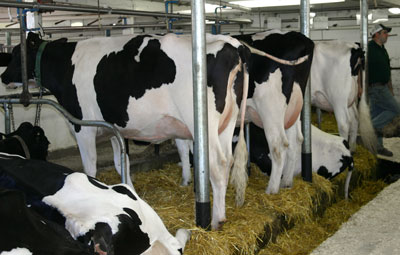
Cows in a tie-stall barn | | |
 | 
| | 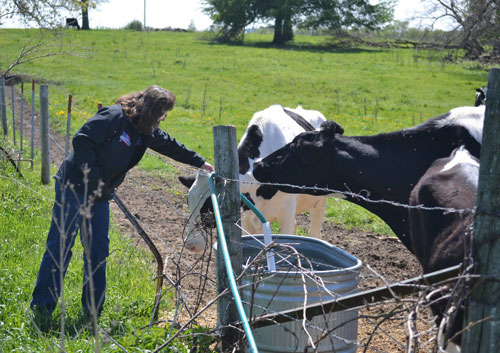 Dairy cattle of every breed require a few basics to be happy and healthy, much the same as people - a balanced diet, clean water, safe and comfortable housing, and basic health (veterinary) care. Most dairymen have decades of experience in caring for cattle, along with a team of professionals such as dairy nutritionists and large animal veterinarians, which help them provide the highest standard of care to their animals. The Holstein Foundation offers a free educational workbook which can give you a basic introduction into what it takes to care for dairy heifers and cows. The workbook, entitled "Working with Dairy Cattle," covers the following topics, among others: - Feeding Heifers and Cows
- Proper Housing for Heifers and Cows
- Health and management
- Calving
- Milking Procedures
- And more!
If you are still interested in learning more about dairy cattle care, visit with a local dairy producer in your area, a veterinarian or your county's dairy or agricultural extension agent for more advice. Recommended Reading: - Holstein Foundation's free educational workbook series
- Visit the Dairy Farming Today web site
| |
 | 
| | 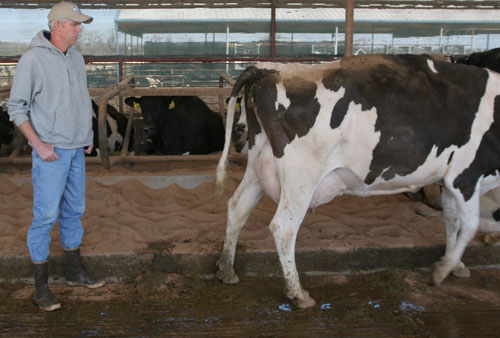
A common question many who are not familiar with the pedigreed livestock industry ask is, "what makes a 'good cow?'" What makes some cows more valuable than others? There are many things which may increase a cow's value over her herdmates, traits which registered breeders seek to improve with each generation. These qualities can be broken down into three basic categories - physical appearance/conformation; milk production; and genetic merit. Animals excelling in any or all of these areas have added value over cows which might not be as outstanding. Let's take a closer look at each and explain a little more... Physical Appearance and Conformation There are two primary ways that female dairy cattle are evaluated on their physical appearance: dairy cattle shows (females of all ages) and linear classification (cows only). 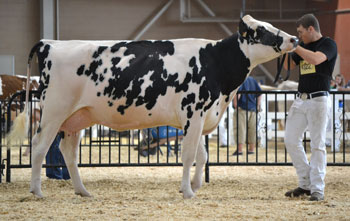 Dairy cattle shows are held around the country, and may be as small as a local or county show with a few dozen animals, or as large as the International Holstein Show at World Dairy Expo, which boasts hundreds of cattle from around the United States and Canada. At shows, animals are divided into classes based on their breed and age. An official judge evaluates each class of animals, and winners are those who, in the judge's opinion, most closely conform to the breed standard. Winners from each class compete for champion honors, and at the end of the day, and Grand Champion of the show is named. Often, if multiple breeds are competing at a show, they will take the Grand Champions of each breed and select a Supreme Champion - the best of the best, on that day. Showing dairy cattle is a very fun and rewarding activity for people of all ages, from a young 4-Her just getting started, to the seasoned breeder. Dairy cattle shows are held around the country, and may be as small as a local or county show with a few dozen animals, or as large as the International Holstein Show at World Dairy Expo, which boasts hundreds of cattle from around the United States and Canada. At shows, animals are divided into classes based on their breed and age. An official judge evaluates each class of animals, and winners are those who, in the judge's opinion, most closely conform to the breed standard. Winners from each class compete for champion honors, and at the end of the day, and Grand Champion of the show is named. Often, if multiple breeds are competing at a show, they will take the Grand Champions of each breed and select a Supreme Champion - the best of the best, on that day. Showing dairy cattle is a very fun and rewarding activity for people of all ages, from a young 4-Her just getting started, to the seasoned breeder. Linear classification is a program performed by Holstein Association USA (and other breed organizations, for their respective breeds). Trained professionals, called "classifiers," travel to farms around the country who wish to have their cattle "classified." On the farm, they evaluate individual animals' physical conformation, compared to breed ideals, and assign each part of the body a score of 1 to 50. After each part is scored, the classifier also assigns a final score, between 50 and 97, falling into one of five categories: -
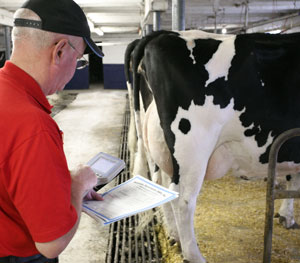 Excellent (90-97 points) Excellent (90-97 points) - Very Good (85-89 points)
- Good Plus (80-84 points)
- Good (75-79 points)
- Fair (65-74 points)
- Poor (50-64 points)
The classification program provides dairy producers with an unbiased evaluation of their animals' physical conformation, and can be used to assist in making breeding decisions, as well as for marketing. With both show animals and animals who receive high classification scores, animals which conform to physical ideals are more valuable than animals with less correct physical conformation. These systems reward animals which possess the physical structure to lead long, productive lives and produce large volumes of high quality milk. Recommended Reading: - PDCA Dairy Cow Unified Scorecard
- Linear Classification Descriptive Traits Brochure
- Holstein Foundation Dairy Judging and Showring Ready Workbooks
Milk Production 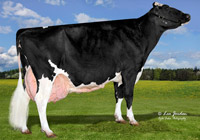 As a cow's milk production is the basis for the majority of dairy producers' income each month, cows that produce large volumes of milk are more desirable than cows which produce less. Holstein cows produce more pounds of milk than any of the other dairy breeds, with the average Holstein producing around 23,000 pounds of milk, or 2,674 gallons, of milk each lactation, which averages out to about 75 pounds, or almost 9 gallons of milk per cow per day. As a cow's milk production is the basis for the majority of dairy producers' income each month, cows that produce large volumes of milk are more desirable than cows which produce less. Holstein cows produce more pounds of milk than any of the other dairy breeds, with the average Holstein producing around 23,000 pounds of milk, or 2,674 gallons, of milk each lactation, which averages out to about 75 pounds, or almost 9 gallons of milk per cow per day. The current world record for milk production in a single lactation is held by Selz-Pralle Aftershock 3918, who produced 78,170 pounds of milk in a year, in 2017.
Recommended Reading: - Current milk production record holders
- Historical leaders for milk production
Genetic Merit While the first two categories apply primarily to females, outstanding genetic merit is directly measured in both cows and bulls. Each Registered Holstein has estimates of genetic merit calculated for them, based on the genetics and actual performance of their ancestors and other related animals. These are in the form of Predicted Transmitting Abilities (PTAs) and are listed on each Official Holstein Pedigree.  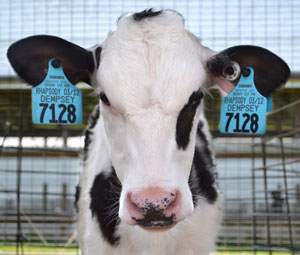 Genetic merit in young animals with no performance information of their own is based on an average of the genetic merit of their parents, referred to as "parental averages." Once an animal starts to have official performance information of their own (such as a milk production record or classification score), that information starts to contribute to their estimates of genetic merit. Genomic testing is a newer technology which analyzes the actual genes an animal possesses (based on a hair sample), which allows breeders to get a more accurate estimate of genetic merit and future performance than ever before, on animals of any age. This technology is especially useful in young animals that have no performance information of their own. Genetic merit in young animals with no performance information of their own is based on an average of the genetic merit of their parents, referred to as "parental averages." Once an animal starts to have official performance information of their own (such as a milk production record or classification score), that information starts to contribute to their estimates of genetic merit. Genomic testing is a newer technology which analyzes the actual genes an animal possesses (based on a hair sample), which allows breeders to get a more accurate estimate of genetic merit and future performance than ever before, on animals of any age. This technology is especially useful in young animals that have no performance information of their own. The Holstein Association updates these estimates of genetic merit three times per year and publishes lists of high ranking animals. The Association has also created a formula to help breeders sort out animals which excel in many traits possessed by profitable cattle, known as the Total Performance Index (TPI). The TPI formula combines various health, conformation, and production traits, and is a common standard used to rank Holstein cattle. Animals ranking high for TPI values, or other important traits, are in demand as breeding stock. There are a few other novel genetic traits an animal may possess which would increase their potential value, such as carrying the polled (naturally hornless) gene, or carrying the gene for red and white hair color. These traits are less common in the Holstein breed, thereby making animals which possess them (particularly if they also excel in other traits) more valuable. Recommended Reading: - About the TPI Formula
- About Holstein Association USA's Genomic Testing Services
- Holstein Foundation's Understanding Genetics and the Sire Summaries Workbook
| |
 | 
| | 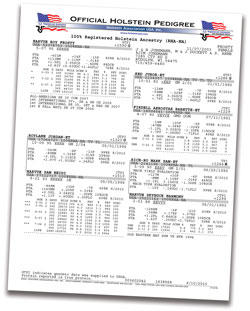
A pedigree is a record of an animal's ancestry. Official Holstein Pedigrees may only be issued by Holstein Association USA, combining a wealth of ancestry, performance and genetic information on a single page. While each animal is different, their information is all presented in the same format, making it easy to evaluate and compare animals. Typical pedigrees include three generations of information on one page, including the animal, its sire and dam, and its paternal and maternal grandparents. Paternal information (related to the sire and his ancestors) is found on the top half of the pedigree, and maternal information (related to the dam and her ancestors) is found on the bottom half of the pedigree. On an Official Holstein Pedigree, you will find: - Registration names and numbers for all animals on the pedigree
- The birthdate of the animal
- Information on the animal's current owner
- Estimates of genetic merit for all animals on the pedigree
- Any current classification scores for all animals on the pedigree
- Any official production records for females on the pedigree
- Any national show winnings or other awards received by animals on the pedigree
Why are pedigrees important? Pedigrees can be useful to owners and breeders because information on an animal's ancestors can help predict how well that animal may perform later in life; for example, how much milk they might produce, or how they will look, conformation-wise, based on how their ancestors performed in those areas. Aside from providing owners and breeders with a great deal of information about their animals, Official Holstein Pedigrees also serve as a verified source of ancestry, performance and genetic information when selling animals, giving the buyer trusted documentation that information presented on the animal is accurate. Recommended Reading: - View a sample Official Holstein Pedigree
- Holstein Association USA's "How to Read an Official Holstein Pedigee" pamphlet
- Holstein Foundation's "Pedigree Questions and Answers" workbook, for more information and interactive exercises!
| |
 | 
| | Show your Holstein pride with one of our free desktop backgrounds. Each features U.S. Registered Holsteins in different settings, and provide the ideal backdrop for any Holstein enthusiast's computer screen. The Holstein Association USA phone number and website are also included, so you never have to search if you need to get in touch with us. Download each desktop for free.
(images are 1680 x 1050 pixels) - Click on the thumbnail below to view the wallpaper (it will open in a new window).
- Right click on the image and select "Save image as..."
- Save to your computer, then find the file and open it.
- Right click on the image and select "Set as Desktop Background"
| 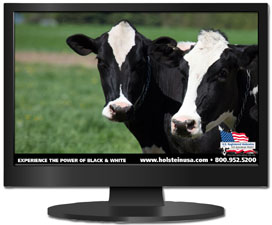 |
| 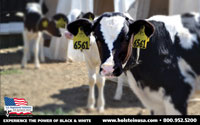 | 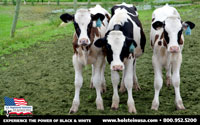 | 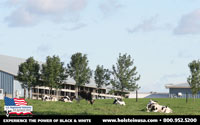 | | 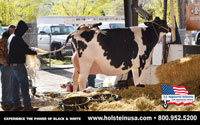 | 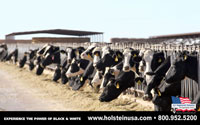 | 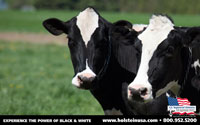 | | Also available for download, a simple Holstein Cow image | | | 
Click the image for a high resolution image. Please contact us if you require the file in a specific format. | | |
 | | | | | |









 Holstein cows typically calve for the first time when they are 23 to 26 months of age, with healthy calves weighing an average of 80 to 100 pounds at birth. Holsteins have a gestation period of nine months.
Holstein cows typically calve for the first time when they are 23 to 26 months of age, with healthy calves weighing an average of 80 to 100 pounds at birth. Holsteins have a gestation period of nine months.
 A plastic or metal tag which is placed in an animal's ear
A plastic or metal tag which is placed in an animal's ear 
 A document showing an animal's lineage, a record of their ancestry; a typical Holstein pedigree shows three generations - the animal itself, its sire and dam, along with their sires and dams. May also list genetic and performance records for each animal, when applicable.
A document showing an animal's lineage, a record of their ancestry; a typical Holstein pedigree shows three generations - the animal itself, its sire and dam, along with their sires and dams. May also list genetic and performance records for each animal, when applicable. 




 Dairy cattle shows are held around the country, and may be as small as a local or county show with a few dozen animals, or as large as the International Holstein Show at World Dairy Expo, which boasts hundreds of cattle from around the United States and Canada. At shows, animals are divided into classes based on their breed and age. An official judge evaluates each class of animals, and winners are those who, in the judge's opinion, most closely conform to the breed standard. Winners from each class compete for champion honors, and at the end of the day, and Grand Champion of the show is named. Often, if multiple breeds are competing at a show, they will take the Grand Champions of each breed and select a Supreme Champion - the best of the best, on that day. Showing dairy cattle is a very fun and rewarding activity for people of all ages, from a young 4-Her just getting started, to the seasoned breeder.
Dairy cattle shows are held around the country, and may be as small as a local or county show with a few dozen animals, or as large as the International Holstein Show at World Dairy Expo, which boasts hundreds of cattle from around the United States and Canada. At shows, animals are divided into classes based on their breed and age. An official judge evaluates each class of animals, and winners are those who, in the judge's opinion, most closely conform to the breed standard. Winners from each class compete for champion honors, and at the end of the day, and Grand Champion of the show is named. Often, if multiple breeds are competing at a show, they will take the Grand Champions of each breed and select a Supreme Champion - the best of the best, on that day. Showing dairy cattle is a very fun and rewarding activity for people of all ages, from a young 4-Her just getting started, to the seasoned breeder. Excellent (90-97 points)
Excellent (90-97 points) As a cow's milk production is the basis for the majority of dairy producers' income each month, cows that produce large volumes of milk are more desirable than cows which produce less. Holstein cows produce more pounds of milk than any of the other dairy breeds, with the average Holstein producing around 23,000 pounds of milk, or 2,674 gallons, of milk each lactation, which averages out to about 75 pounds, or almost 9 gallons of milk per cow per day.
As a cow's milk production is the basis for the majority of dairy producers' income each month, cows that produce large volumes of milk are more desirable than cows which produce less. Holstein cows produce more pounds of milk than any of the other dairy breeds, with the average Holstein producing around 23,000 pounds of milk, or 2,674 gallons, of milk each lactation, which averages out to about 75 pounds, or almost 9 gallons of milk per cow per day. 
 Genetic merit in young animals with no performance information of their own is based on an average of the genetic merit of their parents, referred to as "parental averages." Once an animal starts to have official performance information of their own (such as a milk production record or classification score), that information starts to contribute to their estimates of genetic merit. Genomic testing is a newer technology which analyzes the actual genes an animal possesses (based on a hair sample), which allows breeders to get a more accurate estimate of genetic merit and future performance than ever before, on animals of any age. This technology is especially useful in young animals that have no performance information of their own.
Genetic merit in young animals with no performance information of their own is based on an average of the genetic merit of their parents, referred to as "parental averages." Once an animal starts to have official performance information of their own (such as a milk production record or classification score), that information starts to contribute to their estimates of genetic merit. Genomic testing is a newer technology which analyzes the actual genes an animal possesses (based on a hair sample), which allows breeders to get a more accurate estimate of genetic merit and future performance than ever before, on animals of any age. This technology is especially useful in young animals that have no performance information of their own.










0 Response to "How To Draw A Holstein Cow"
Post a Comment